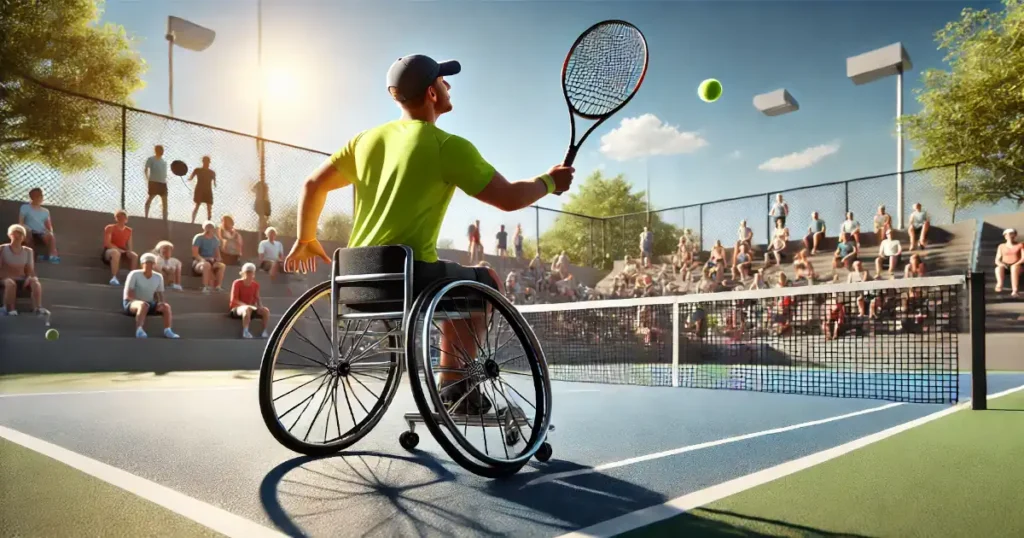Introduction to Wheelchair Tennis
Wheelchair tennis is a dynamic and competitive sport that allows athletes with physical disabilities to enjoy tennis at both recreational and professional levels. It has gained global recognition, thanks to its thrilling matches and the extraordinary skill of its players. This variant of tennis follows the core principles of the traditional game, with some modifications tailored to the needs of the athletes. The sport has grown immensely since its inception, attracting not only players but also a wide fan base that admires the dedication and resilience of these athletes.
The development of wheel chair tennis can be traced back to the 1970s when Brad Parks, a pioneer in the sport, began experimenting with tennis as a form of rehabilitation. From these humble beginnings, wheel chair tennis has evolved into a global phenomenon, with professional tournaments and a presence at prestigious events like the Paralympics and Grand Slams. The increasing visibility of wheel chair tennis has also contributed to its popularity, as the sport continues to break barriers and inspire athletes worldwide.
How Is Wheelchair Tennis Played?
The Basic Rules of Wheelchair Tennis
Wheelchair tennis follows many of the same rules as traditional tennis, but with a few essential adaptations. The most significant modification is the two-bounce rule, which allows players to let the ball bounce twice before returning it. The first bounce must still land within the boundaries of the court, while the second can land anywhere, giving players more time to maneuver their wheelchairs and position themselves for the return.
The court dimensions remain the same as in traditional tennis, and players use standard tennis rackets and balls. Matches can be played in singles or doubles formats, and the scoring system is identical to traditional tennis, with points, games, and sets determining the outcome.
Types of Wheelchairs Used in Tennis
Athletes in wheelchair tennis use specially designed sports wheelchairs, engineered to offer maximum agility, speed, and stability. Unlike everyday wheelchairs, these sports chairs have cambered wheels that tilt outward, providing better balance and allowing for quick turns. The lightweight frame helps players accelerate and decelerate smoothly while navigating the court.
In addition to the unique design of the wheelchairs, players can also customize their chairs to fit their individual needs and playing styles. These adjustments ensure that athletes can perform at their best, using equipment that enhances their mobility and control on the court.
Key Strategies and Techniques in Wheelchair Tennis
Mobility is a critical aspect of wheelchair tennis. Players must be constantly aware of their positioning on the court, adjusting their speed and direction to reach the ball efficiently. Effective chair control is a skill that takes time to master, as athletes must quickly move into position and recover after each shot. Upper body strength and coordination are essential, as players rely on their arms for both propelling the wheelchair and hitting the ball.
Specific strategies in wheel chair tennis include using angled shots to force opponents to move across the court, exploiting the two-bounce rule, and maintaining a strong serve to keep the advantage. Players must also develop excellent endurance, as maneuvering the wheelchair throughout a match requires significant physical effort.
How Long Is a Wheelchair Tennis Match?
Structure of a Wheelchair Tennis Match
The structure of a wheel chair tennis match is similar to that of traditional tennis, with matches played in best-of-three or best-of-five sets. Each set consists of games, and the first player to win six games with a two-game advantage takes the set. In the event of a tie at 6-6, a tiebreaker game may be played, just as in traditional tennis.
The scoring system remains the same, with points counted as 15, 30, 40, and game. Wheelchair tennis players must adapt their strategies to account for the two-bounce rule, which can extend the length of rallies and alter the pace of the game.
Factors That Affect Match Duration
Several factors can influence the length of a wheel chair tennis match. The physical endurance of the players is a major consideration, as moving the wheelchair around the court requires significant energy and stamina. Additionally, the two-bounce rule can lead to longer rallies, as players have more time to reach the ball, which may prolong the match.
Tournament-specific rules may also play a role in determining match length. For example, some events may use a best-of-three sets format, while others may require five sets to declare a winner. Environmental factors, such as weather conditions, can further affect the duration of outdoor matches.
The Difference Between Tennis and Wheelchair Tennis
Mobility and Movement on the Court
One of the most noticeable differences between traditional tennis and wheelchair tennis is how players move on the court. In traditional tennis, athletes rely on their legs to run, sprint, and change direction rapidly. In contrast, wheelc hair tennis players use their arms to push and steer their wheelchairs, which requires a different set of physical skills and coordination.
This difference in mobility impacts the playing style, as wheel chair tennis players must anticipate shots earlier and position themselves strategically. The use of specialized wheelchairs also changes the way players interact with the court, as they need to maintain momentum while executing precise turns and strokes.
Rules and Equipment Modifications
The two-bounce rule is the most significant rule modification in wheel chair tennis. This rule gives players extra time to reach the ball, allowing them to stay in rallies and create more dynamic exchanges. However, the equipment, such as the rackets and balls, remains identical to those used in traditional tennis.
Wheel chair tennis players must also manage the added complexity of moving their wheelchairs while playing. This requires a deep understanding of how their chair interacts with the court surface, as well as precise control over their movements.
Mental and Physical Challenges
Wheelchair tennis players face a unique set of mental and physical challenges. Physically, they must develop upper body strength and endurance to handle the demands of the sport, particularly when maneuvering their wheelchairs over extended periods. The mental aspect of the game is equally important, as players need to stay focused and resilient, especially during long rallies and close matches.
Additionally, wheelchair tennis players often need to adapt their strategies to exploit the two-bounce rule while defending against opponents who can move just as quickly on the court. Success in wheel chair tennis requires a combination of mental fortitude, physical strength, and tactical acumen.
Is Wheelchair Tennis in the Olympics?
Introduction of Wheelchair Tennis to the Paralympics
Wheel chair tennis made its debut in the Paralympic Games in 1992, in Barcelona, marking a significant milestone for the sport. Since then, it has become a regular feature of the Paralympic Games, with athletes from around the world competing for medals on the international stage.
Although wheelchair tennis is not included in the Olympics, its presence in the Paralympics showcases the skill and dedication of its athletes, who compete at the highest level of the sport.
Major Achievements in Paralympic Wheelchair Tennis
Paralympic wheelchair tennis has seen remarkable achievements over the years, with athletes pushing the boundaries of the sport. Notable figures like Shingo Kunieda and Esther Vergeer have dominated the courts, winning multiple Paralympic gold medals and setting new standards of excellence in the game. Their contributions have elevated the profile of wheel chair tennis and inspired a new generation of players.
Major Tournaments and Championships in Wheelchair Tennis
The Grand Slam Tournaments
Wheelchair tennis has earned a place in the four Grand Slam tournaments: the Australian Open, the French Open, Wimbledon, and the US Open. These prestigious events provide a platform for wheelchair athletes to compete alongside traditional tennis players, showcasing their talent on the world stage.
Inclusion in the Grand Slam tournaments has been a significant achievement for wheel chair tennis, as it brings the sport to a broader audience and highlights the skills of its top players.
The ITF Wheelchair Tennis Tour
The International Tennis Federation (ITF) Wheelchair Tennis Tour is a global circuit of tournaments that cater to players of all levels, from beginners to elite athletes. The tour features different tiers of competition, with players earning ranking points based on their performance.
The ITF Wheel chair Tennis Tour plays a crucial role in the development of the sport, offering opportunities for athletes to compete, improve their skills, and rise through the ranks.
The Paralympic Games and Wheelchair Tennis
The Paralympic Games remain the pinnacle of achievement in wheelchair tennis, with athletes from around the world competing for gold. The games provide a unique opportunity for wheelchair tennis players to represent their countries and showcase their abilities on the grandest stage.
Over the years, Paralympic wheel chair tennis has delivered unforgettable moments, with intense matches and incredible displays of athleticism.
Famous Wheelchair Tennis Players and Their Contributions
Pioneers of Wheelchair Tennis
The early pioneers of wheelchair tennis laid the foundation for the sport we know today. Figures like Brad Parks, who is credited with founding the sport, helped to establish the rules and structure that allowed wheel chair tennis to grow into an international phenomenon.
Their contributions to the sport go beyond the court, as they worked tirelessly to promote wheel chair tennis and inspire others to take up the game.
Modern-Day Legends
Today, wheelchair tennis boasts a roster of modern-day legends who have achieved incredible success. Players like Shingo Kunieda and Diede de Groot continue to dominate the sport, winning multiple titles and setting new records. Their achievements serve as a testament to the skill and determination required to excel in wheel chair tennis.
The Global Impact and Growth of Wheelchair Tennis
Growth of the Sport in Various Countries
Wheelchair tennis has experienced significant growth in many countries, thanks to the efforts of national associations and international organizations. Programs that promote inclusivity and provide resources for athletes with disabilities have helped to expand the sport’s reach, attracting new players from all over the world.
In countries like the United States, the United Kingdom, and Japan, wheel chair tennis has gained a strong following, with athletes participating in national and international competitions.
Media Coverage and Sponsorship
In recent years, wheelchair tennis has received increased media coverage, particularly during major tournaments like the Paralympics and Grand Slams. This exposure has helped to raise awareness of the sport and its athletes, attracting sponsorship deals that provide financial support to players and tournaments.
The role of sponsorship in wheel chair tennis cannot be overstated, as it helps to fund equipment, training, and travel for athletes, allowing them to focus on their performance.
Wheelchair Tennis for Beginners
How to Get Started in Wheelchair Tennis
For beginners looking to get started in wheelchair tennis, the first step is to find a local club or program that offers training and coaching. Many national and regional tennis associations provide resources and support for new players, including access to specialized equipment and coaching.
Basic Equipment for New Players
New players will need a sports wheelchair designed for tennis, as well as a standard tennis racket and balls. It’s important to choose a wheelchair that fits well and allows for easy movement on the court. Beginners should also invest in proper protective gear to prevent injuries during play.
Importance of Training and Coaching
Training and coaching are essential for new players to develop their skills and confidence on the court. A professional coach can provide guidance on techniques, positioning, and strategies, helping beginners to improve quickly and enjoy the game.
The Future of Wheelchair Tennis
Innovations in Wheelchair Technology
As technology continues to advance, so too does the design of sports wheelchairs. Innovations in materials, construction, and ergonomics are helping to create wheelchairs that are faster, lighter, and more comfortable for athletes. These developments are likely to have a significant impact on the future of wheelchair tennis, enabling players to reach new levels of performance.
Increasing Inclusivity in Sports
The push for greater inclusivity in sports is gaining momentum, with wheel chair tennis leading the way. Efforts to make the sport more accessible to individuals with disabilities are being embraced by organizations around the world, with initiatives focused on increasing participation and providing opportunities for athletes of all abilities.
Conclusion
Wheelchair tennis is a challenging and rewarding sport that continues to grow in popularity worldwide. With its roots in rehabilitation and its presence on the global stage, the sport has come a long way since its inception. As technology advances and inclusivity efforts expand, the future of wheelchair tennis looks brighter than ever, offering exciting opportunities for players and fans alike.
Frequently Asked Questions (FAQs)
What is the main difference between wheelchair tennis and traditional tennis?
The primary difference is the two-bounce rule in wheel chair tennis, allowing the ball to bounce twice, giving players extra time to reach it.
Can anyone play wheelchair tennis, or do you need specific equipment?
Yes, anyone with mobility challenges can play, but a specially designed sports wheelchair is required for effective movement on the court.
How long does a typical wheelchair tennis match last?
A match usually lasts between 1 to 3 hours, depending on the number of sets and the players’ endurance.
Is wheelchair tennis part of the Paralympic Games?
Yes, wheelchair tennis has been a part of the Paralympic Games since 1992, allowing athletes to compete for medals.
What are some strategies unique to wheelchair tennis?
Players focus on mobility, positioning, and utilizing the two-bounce rule while maintaining upper body strength for quick maneuvering.
Who are the top players in wheelchair tennis today?
Some of the top players include Shingo Kunieda and Diede de Groot, who have both achieved significant success in the sport.







